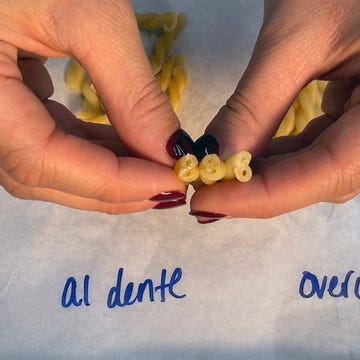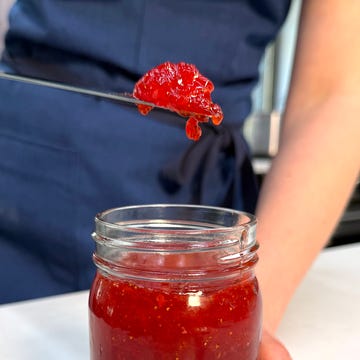One of the most frustrating tasks in the kitchen is grating blocks of cheese by hand. And for recipes that call for a lot of it, like pizza or mac and cheese, the process requires even more upper body strength. The hassle of grating cheese yourself makes the convenience of the pre-shredded packages especially appealing.
You can find cheddar, mozzarella, and multi-cheese blends in the dairy aisle of any grocery store. The variety available means that you can use shredded cheese in virtually any recipe—but it comes at a cost. To prevent the cheese from clumping together, manufacturers will coat each shred in anti-caking agents.
Food experts everywhere—including at Delish—suggest that you steer away from the pre-shredded stuff for culinary reasons. The additives keep the cheese from sticking together in the bag, sure, but they also prevent the cheese from melting evenly (which can be disastrous for recipes like mac and cheese).
Culinary shortcomings aside, we can still admit that pre-shredded cheese is still the most convenient option. But how do these anti-caking agents affect the cheese from a nutrition perspective? We consulted Dr. Bryan Quoc Le, food scientist and author of 150 Food Science Questions Answered, to unpack everything you need to know about pre-shredded cheese.
Are Anti-Caking Agents Safe To Eat?
Anti-caking agents prevent shredded cheese from clumping together, and there are several different types of additives that can achieve that result. “The main anti-caking agents used in shredded cheese include cellulose, starch, calcium sulfate, and sodium aluminosilicate,” Le says.
The additive used in your cheese depends on the brand, but all of them are recognized as safe by the FDA. Kraft, for instance, uses cornstarch. Tillamook and Sargento both add potato starch to their shredded cheese, and the latter also uses powdered cellulose.
The truth is, you likely already consume these ingredients in other foods. You may recognize corn and potato starch already, but cellulose is also widely used in the food industry. Cellulose is a naturally occurring source of fiber in plants. On an industrial level, however, manufacturers will use a processed cellulose derived from wood pulp. It is used to improve texture and stabilize foods like ice cream, yogurt, spice blends, and salad dressings.
How Do Anti-Caking Agents Affect The Nutrition Of Shredded Cheese?
You may be able to notice the sandy coating on each shred or taste a gritty consistency when the cheese melts, but the primary ingredient in your bag of shredded cheese is still the cheese itself. The anti-caking agents are present, but not in large enough quantities to seriously impact the overall nutritional value.
Each additive is digested differently. Starches will slightly add to the amount of carbohydrates and calories you consume. Certain chemical additives like calcium sulfate and sodium aluminosilicate can contribute marginal amounts of micronutrients. Cellulose, because it’s not digestible, serves as an added source of dietary fiber.
But before you take these nutritional contributions too seriously, it’s worth noting that these additives have little impact on your diet, if any. “The use rate of these anti-caking agents is nearly negligible and will not raise any of these nutritional factors by very much,” Le says.
When it comes to optimizing the texture of your food, we’ll always recommend grating cheese yourself. But if you're going for convenience, pre-shredded cheese is still a safe option.














